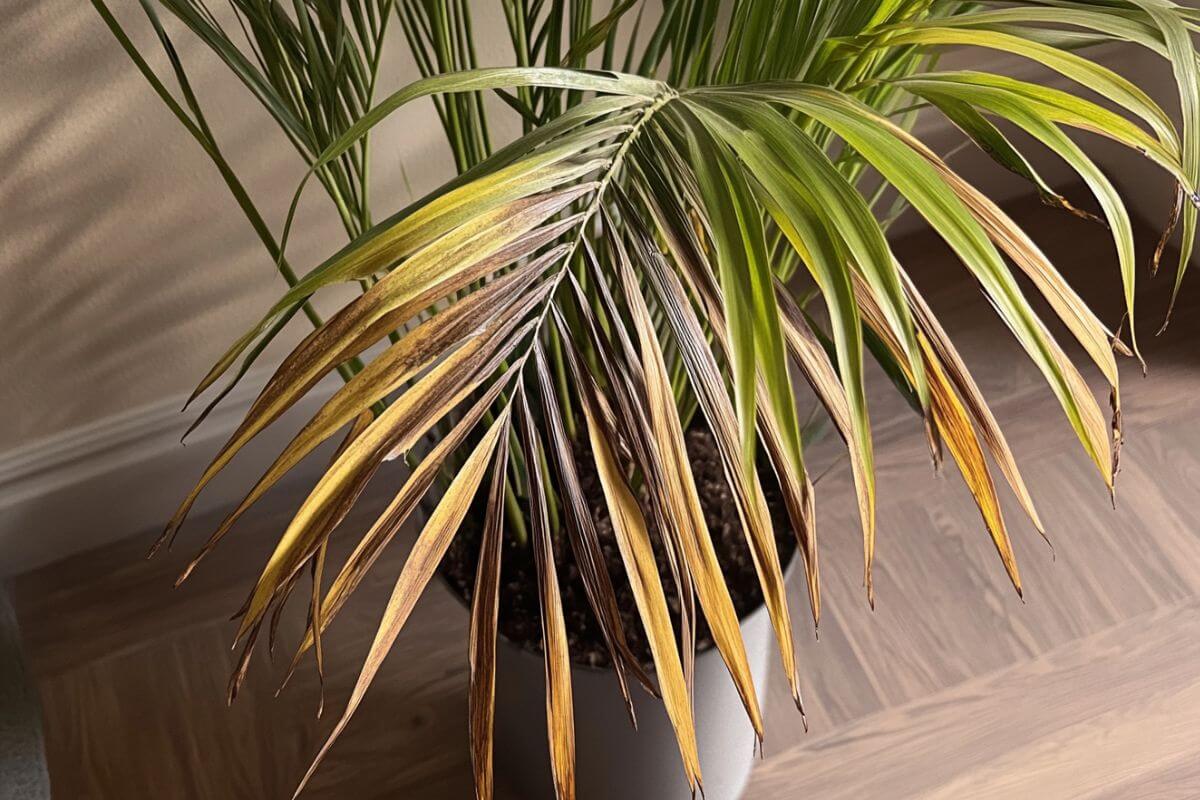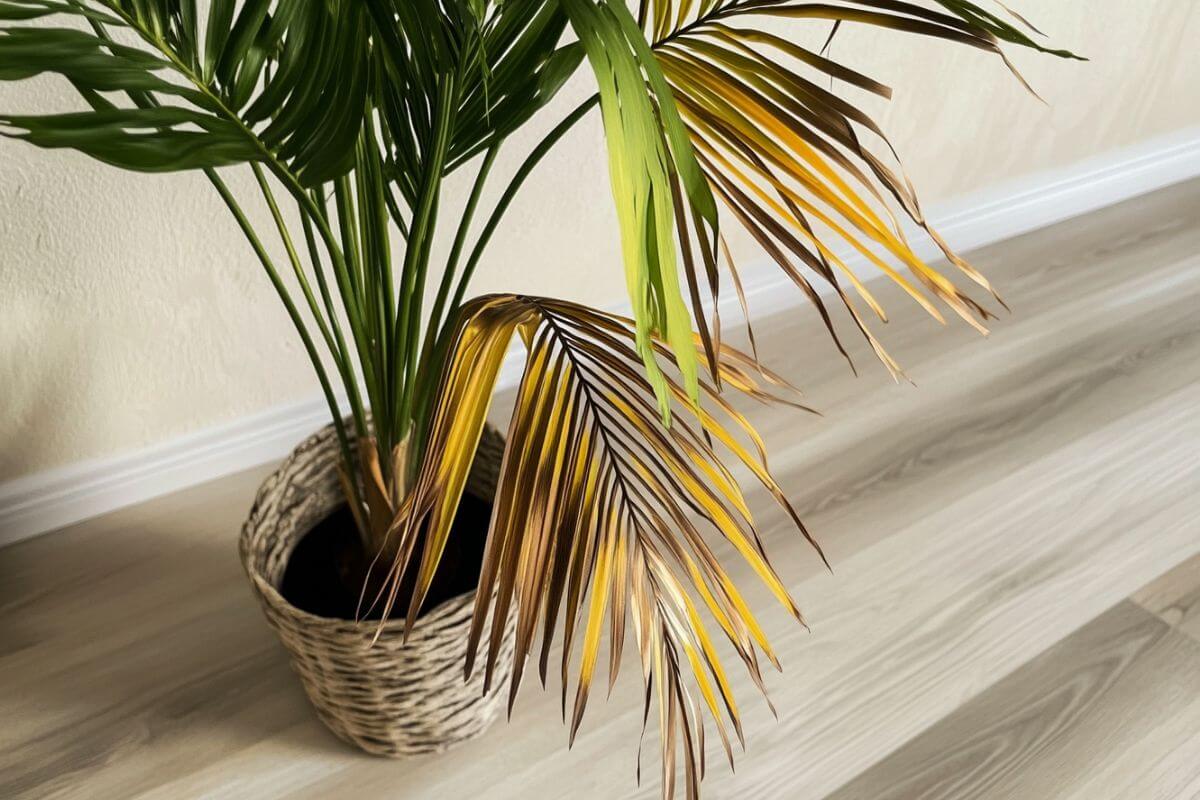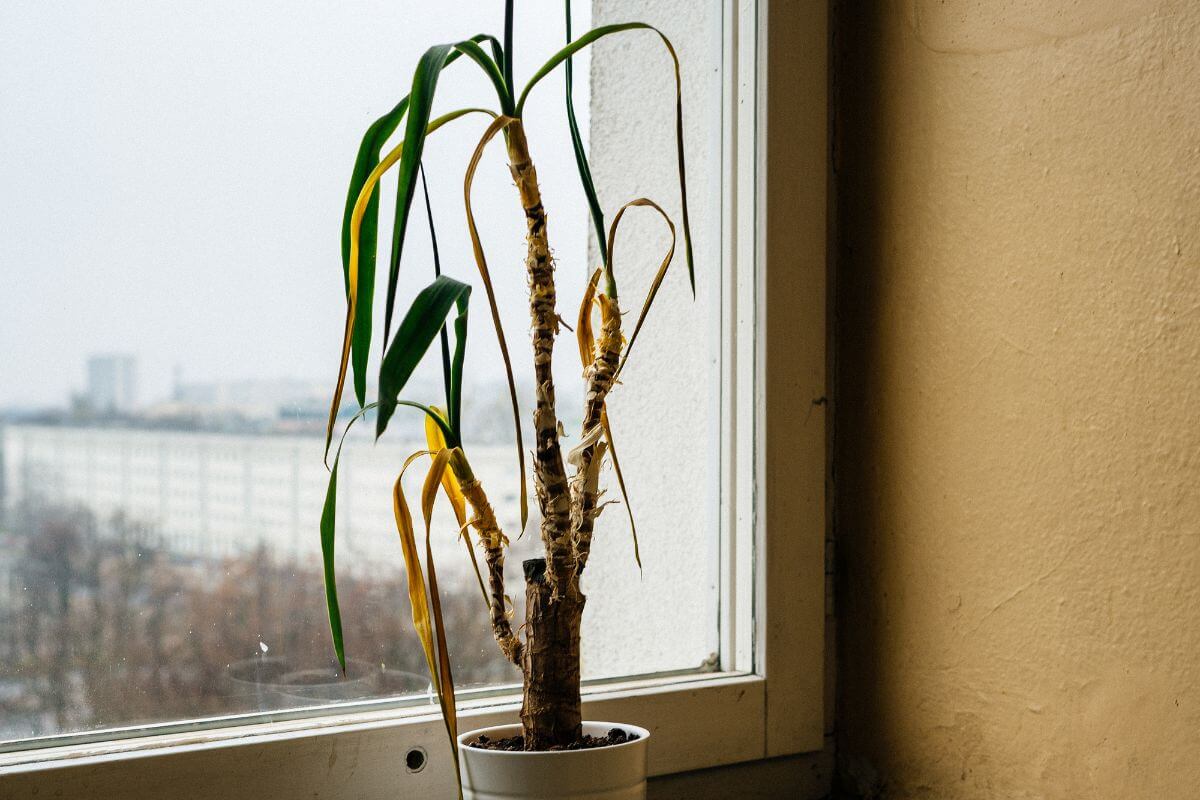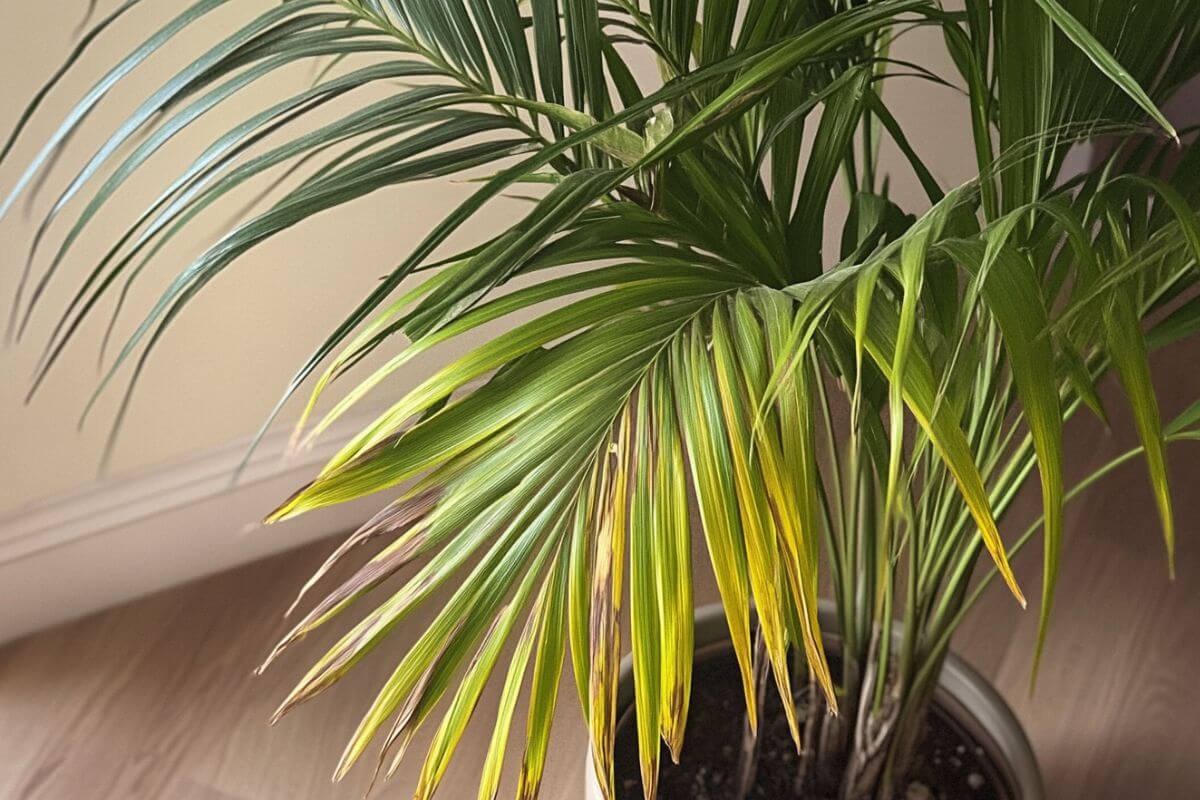If your indoor palm looks unhealthy, you may be wondering if it’s dying and if you can revive it. Or if you are destined to acquire a new one.
Even if you’re giving your indoor palm tree great care, you never know what may be afflicting the palm. So you’ll want to keep an eye out for signs and symptoms that the palm is unhealthy and could be dying.
Can a dying indoor palm tree be revived? Yes, indoor palms can be revived. But first, you need to identify what the issue affecting its health is, so you know how to revive it.
If you think your indoor palm tree is dying, keep reading below for common causes and how to revive your indoor palm.
Palm Types
Not all types of indoor palms are the same, although care for indoor palm plants is similar. Common indoor palm tree species include:
- Areca palm
- Bamboo palm
- Fan palm
- Fishtail palm
- Kentia palm
- Lady palm
- Madagascar palm
- Majesty palm
- Parlor palm
- Ponytail palm
While some palms adapt nicely to lower light conditions, a few require bright light, moist soil, and high humidity. If environmental conditions are inadequate, your palm can die a slow agonizing death.
Why is My Indoor Palm Tree Dying?

Several factors can cause an indoor palm to be in distress, including:
- Climate Environment
- Soil and Growing Medium
- Light
- Watering
- Nutrition
- Pest Infestations
- Diseases
- Excessive Pruning
We’ll investigate them further below.
8 Common Causes of a Dying Palm and How to Intervene to Save Your Tree
Any of these factors, when mismanaged, can cause your indoor palm to be sick.
1. Climate Environment
Sudden changes in the environment can lead to unhealthy indoor plants.
Palms don’t enjoy being relocated. Don’t move your tree around. Choose a spot and leave it there if possible.
Another consideration is if you are moving an outdoor palm indoors. Sometimes they cannot adjust to the dramatic change.
Palms do not appreciate cold or hot drafts that are drastically different from the current indoor temperature. They also don’t like dead air. Air circulation is a must.
Recommended Fixes and Solutions:
Choose your palm’s location carefully and then resist moving too much afterwards. Avoid drafty areas and if you do not have good air circulation, consider running a fan on low in the room.
When potting your palms, avoid overcrowding. Use division on clumps to give your palm adequate space. Indoor palms prefer warm temperatures ranging somewhere between 50° and 85°F.
2. Soil and Growing Medium

A common problem may be poor drainage of your potting soil. This can be the cause of root rot and is lethal for palms.
The soil needs aeration, so that roots get enough oxygen.
Salt buildup from watering and fertilizers can also place your palm at risk. Brown leaf tips hint at this.
Recommended Fixes and Solutions:
When selecting your growing medium, it must drain well. Loamy soil is best for all this.
Your pot or container should have a sufficient number of drainage holes to prevent soggy soil and root rot.
Keep your soil moist. Moist does not mean soggy or waterlogged, but damp. Potting mix specifically blended for palms is the best choice.
You can mix your own by amending standard potting soil with peat moss, perlite, coir, or vermiculite to help retain moisture. Another option is two parts of peat moss blended with one part sand. At least 30% sand will enhance drainage.
To address salt buildup, flush the soil monthly with collected rainwater, or filtered or distilled water. It’s best to stay away from tap water to avoid additional mineral deposit buildup.
Also, keep in mind the planting depth of your palm tree. The palm’s root ball should be surrounded by a nice layer of soil, but it should not be buried deep underneath the soil bed.
Palms can take a turn for the worse when repotted. Palms can manage when a bit rootbound, but you will need to water more frequently as there will be less soil.
If you need to repot, avoid disturbing the root ball as much as possible by adding soil to the bottom and the sides.
3. Amount of Light

Like water, there can be too much or too little sunlight. Even though indoor palms rarely suffer from too much sun exposure, they can still be subject to sunburn just like us, especially younger palms.
Direct light for an extended period of time will lead to scorched leaves.
Brown palm fronds may indicate that your palm is not getting enough light exposure.
Recommended Fixes and Solutions:
Provide indoor palms a good source of light near a south-facing window, or by an east or west-facing window.
Manage light levels, making sure that it is bright indirect light and not too harsh.
4. Watering
Overwatering is a problem common to all houseplants and an indoor palm is no exception. Palms are also subject to root rot when overwatered. Typical overwatering diseases include Phytophthora and Armillaria.
They can also develop fungal infections due to excessive watering. Fronds turn brown and die off, and younger foliage never develops.
Underwatering can also lead to brown leaves and tips. Low humidity humidity levels will also have the same leaf browning.
Recommended Fixes and Solutions:
If you think your palm is the victim of overwatering, you will need to remove your palm from its container to inspect the root ball. If the roots smell, are mushy, or black, your tree has root rot.
Trim the affected roots and place the palm in fresh soil. Allow the soil to dry before giving the palm water again or it will lead to excess water.
As soil needs to be moist, frequent watering may be needed during the spring and summer when palms absorb more water. Wait until the top inch of soil is dry to water.
In the winter months, soil will dry out more slowly as it’s in the dormancy period and the palm isn’t growing. Only hot spells will require increased watering. Once the palm is rooted and accustomed to its location, it will develop a bit of resistance to drought.
Palms generally enjoy humidity levels above 50%, therefore a good humidifier is beneficial. Misting your palm can help, but will not resolve the need for increased humidity. A water tray can help to go the inexpensive route.
5. Nutrient Deficiency
A common missing nutrient that will affect the overall health of your palm is manganese.
A magnesium deficiency will lead to fronds that will tend to wither up and die. Newer fronds will not be able to develop tips, and mature fronds will show yellow patches or streaks and gradually weaken.
Another common nutrient that palms can lack is potassium. A potassium deficiency can cause yellow or brown fronds.
When necrosis sets in, the foliage will lose its tips and begin to curl. A Frizzle Top may develop with fronds assuming a crispy appearance, giving the tree a frizzled look, hence the name.
Recommended Fixes and Solutions:
Your palm needs to be fed if there’s a nutritional deficiency.
The best diet for palms will be a fertilizer specifically formulated for palm trees. These fertilizers incorporate nutrients necessary for palms, and specifically, extra manganese and extra potassium.
You can begin to feed your palm tree as winter finishes or at the beginning of the spring. Continue fertilization through autumn.
Other important nutrients for your palm’s overall health include calcium and iron. When fertilizing, be careful of fertilizer burn. Apply fertilizer several inches away from the roots to prevent burning them.
6. Pest Infestations
The most common pests that indoor palms are at risk of are spider mites, mealybugs, or whiteflies.
Check the leaves and near stems for webs or cotton-like deposits that are signs of pests.
Recommended Fixes and Solutions:
Spray your palm with water to hose off pests. Follow that by treating your palm, especially underneath leaves, with insecticidal soap or a horticultural pesticidal oil such as neem oil.
Repeat the process weekly until pests disappear.
Read about Organic Pest Control Methods.
7. Diseases

Palms are most susceptible to fungal infections and appear as leaf spots or black lesions.
The diseased leaves can eventually die and fall off the palm.
Recommended Fixes and Solutions:
If you notice any symptoms, remove infected plants immediately, so they don’t spread any diseases to other plants.
Prune affected fronds from dead tissue and black spots. If the infection is extensive, try using a copper fungicide.
8. Excessive Pruning
While many houseplants benefit from pruning, palm trees do not if pruning is excessive.
Palm trees are monocots, meaning they produce single seed leaves. Trees that are categorized as dicots have two seed leaves. What does all that mean?
If a frond dies on a palm tree, it will not be able to replace the dead leaf. New foliage will grow only at the tree’s top. Too much pruning will leave a tree bare and unable to regenerate missing leaves.
Another thing to keep in mind is that if you have a single trunk palm tree and cut the top, perhaps to control height, you will kill the palm. Trimming brown tips will not resolve the tree’s appearance if you don’t know the cause.
Recommended Fixes and Solutions:
Only prune infected, dead or dying fronds, avoid pruning otherwise.
Always use a sharp sterilized blade or pruning shears when trimming. Avoid cutting into green stems. It’s ok to leave a bit of brown where you prune.
Reviving a Dying Indoor Palm Trees Final Thoughts
As palm tree lovers, you’ll want your palm tree to be healthy and happy. Evaluate your palm carefully for telltale problem signs and evaluate its care and maintenance to date as well.
Follow our recommendations for proper care and maintenance, and your palm should return to its former glory in no time at all, regardless of the palm species.
Here are other articles on caring for palms:
Indoor Palm Tree Dying FAQs
Should I cut off brown palm leaves?
Yes, it’s best to cut off brown palm leaves as they are dying or dead leaves. But be careful not to damage the plant while doing this. Cutting healthy parts of leaves or stems can negatively affect the palm tree.
Do palm trees grow back when cut?
No, if you cut palm trees at the trunk, there won’t be new growth. If cut the trunk, the palm will most likely die. If it’s a clustering palm with multiple stems, the specific stem that’s cut will not grow back, but the other stems will continue to grow.
What is the Life Expectancy of a Palm Tree?
Some varieties of palms can live up to 100 years, but the average palm tree lives for 70 years. The better care you give it and the closer to its native environmental conditions, the longer they’ll live. If the palm species you have is native to the tropics, be sure to grow it in warm temperatures and high humidity.
How do you revive a dying indoor palm tree?
If you want to revive a dying indoor palm, then you need to remove all the dead and damaged leaves first. If it’s just parts of leaves that are damaged, use sterilized pruning shears to trim off parts that are dead. It’s fine if there’s still a little part that’s brown. Palms are slow growers, so don’t worry if there’s no immediate revival.
Can a dead palm tree come back to life?
No, unfortunately it’s not possible for a dead palm tree to come back to life. If it’s not dead yet, you can still revive the palm tree. However, the only thing you can do with a dead palm tree is remove it and to plant another palm tree.
Why are the leaves on my indoor palm tree turning brown?
The leaves on your indoor palm tree could be turning brown because of a lack of light. If you want to save your indoor palm tree, place it in a spot that receives plenty of sunlight. Another reason could be too much water. You may also notice some yellowing in addition to the browning of the leaves. Overwatering leads to root rot.
What does an overwatered palm tree look like?
An overwatered palm tree looks like a dying one. The leaves start drooping, the leaves will start turning brown, and the palm tree stops growing. If you notice your palm tree has these symptoms, then it needs to be taken care of immediately.
Why is my indoor palm drooping?
Your indoor palm is probably drooping because it’s overwatered or dehydrated. To prevent this from happening, you should monitor the soil and check the top couple inches to see if it’s dry. When the indoor palm is drooping, it’s a sign of a problem with the palm, so you’ll want to check for issues.
Can brown palm leaves turn green again?
No, brown palm leaves are dying or dead leaves. They won’t turn green again, so it’s best to trim the brown parts of the leaves off. This way, you’re removing the dead parts without damaging any living parts. Once you’ve removed the dead parts, make sure to keep them away from direct sun exposure.
How can you tell if a palm tree is diseased?
A healthy palm tree has green leaves, while the leaves of a sick and diseased palm tree may be yellowish or brownish. If you notice drooping leaves , then you know that the palm tree isn’t doing well. These are good indicator of whether or not the palm tree is infected by a disease.


